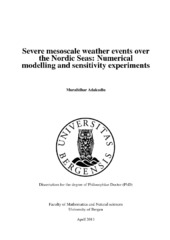| dc.contributor.author | Adakudlu, Muralidhar | eng |
| dc.date.accessioned | 2011-08-09T09:23:52Z | |
| dc.date.available | 2011-08-09T09:23:52Z | |
| dc.date.issued | 2011-06-22 | eng |
| dc.identifier.isbn | 978-82-308-1795-7 (print version) | en_US |
| dc.identifier.uri | https://hdl.handle.net/1956/4870 | |
| dc.description.abstract | The Nordic seas region, due to its unique geographical and climatological conditions, experiences a number of adverse mesoscale weather events that have proven fatal for human activities in the area. Most of these weather events occur in the winter season and include orography-induced wind extremes, shallow and sharp fronts that often form in the vicinity of the ice edge and intense storms called polar lows. In order to assess such high impact weather conditions, a field campaign was conducted over the Nordic seas in February-March 2008 as part of the IPY-THORPEX project. During this field campaign, measurements of a number of severe weather cases were collected through the dropsonde and lidar sensors on-board the DLR-FALCON aircraft. This thesis deals with high resolution modeling experiments of some of the cases observed during the IPY-THORPEX field campaign, with focus on the sensitivity of these events to underlying surface conditions and several physical factors. The results of these experiments are presented in the form of three scientific articles. Paper-I presents the airborne measurements of a case with strong gap winds observed at the exit region of the Hinlopen Strait in Svalbard archipelago. The DLRFALCON aircraft flew along the Hinlopen strait and recorded winds of strength ~ 20 ms−1, which was about four times higher than the upstream wind, near to the surface. In addition, formation of a wake with return currents in the lee of the terrain was also recorded by the lidar sensors carried by the aircraft. This case was simulated in a fineresolution numerical model with a high degree of accuracy. The simulations showed the existence of small-scale cloud banners extending downstream of the lee of the mountains. The causal mechanisms for such cloud features were investigated through an idealised approach. The ideal experiments indicated that the vertical circulations set up by the terrain features cause the cloud banners and a relatively warm ocean surface maintains them by supplying moisture and buyoancy. In paper-II, numerical simulations of another adverse weather case occurred during the IPY-THORPEX field campaign is described. The simulations indicated the formation of a low pressure system at the surface over the Barents Sea on 29 February 2008. Later on, the low intensified while propagating in a northwestward direction and crossed the ice-edge on 1 March followed by its dissipation. The sensitivity of this surface low to underlying surface conditions is explored in two sensitivity experiments, wherein the ice-cover was removed in the first and the sea-surface temperature was raised by 5 K in the second. The Barents Sea surface low persists for a longer duration in the no-ice experiment but eventually dissolves, perhaps due to high static stability in the region. In the second experiment with warmer sea-surface temperature, the surface low is found to persist near the Svalbard archipelago, leading to a significant advection of cold and stable Arctic air over to the warmer Norwegian Sea. This situation triggers an intense polar low over the Norwegian Sea. Certain dynamical aspects of this polar low are also presented in this paper. The sensitivity of polar lows to upper-level features and important physical factors such as static stability, baroclinicity and surface heating is the subject of paper-III. The study was carried out in a numerically set idealised baroclinic channel with a horizontal grid spacing of 10 km. The formation of polar lows was forced in the channel by imposing a finite amplitude perturbation at the tropopause level at the initial conditions. A number of sensitivity experiments were conducted, each with a different set of initial conditions that differ in the degree of baroclinicity, static stability, surface heating and the scale of upper-level perturbation. This paper shows that the pattern of the vertical motion associated with a polar low is highly sensitive to the amount of baroclinicity and surface heating. Static stability appears to have more profound influence on the growth rate of the polar low than on the associated vertical motion. The structure and scale of the polar low happens to be directly proportional to the features of upper-level perturbation. | en_US |
| dc.language.iso | eng | eng |
| dc.publisher | The University of Bergen | en_US |
| dc.relation.haspart | Paper I: Idar Barstad and Muralidhar Adakudlu. 2011. Observation and modelling of gap flow and wake formation on Svalbard. Accepted version. Quarterly Journal of Royal Meteorological Society. Copyright 2011 Royal Meteorological Society. Published by John Wiley & Sons. All Rights Reserved. The published version is available at: <a href= "http://dx.doi.org/10.1002/qj.782" target="blank">http://dx.doi.org/10.1002/qj.782</a> | en_US |
| dc.relation.haspart | Paper II: Muralidhar Adakudlu and Idar Barstad. 2011. Impacts of the ice-cover and seasurface temperature on a polar low over the Nordic Seas: A numerical case study. Quarterly Journal of Royal Meteorological Society. Accepted version. Copyright 2011 Royal Meteorological Society. Published by John Wiley & Sons. All Rights Reserved. The published version is available at: <a href= "http://dx.doi.org/10.1002/qj.856" target="blank"> http://dx.doi.org/10.1002/qj.856</a> | en_US |
| dc.relation.haspart | Paper III: Muralidhar Adakudlu. 2011. Impacts of different initial conditions on the growth of polar lows: Idealised baroclinic channel experiments. In review. Quarterly Journal of Royal Meteorological Society.Copyright 2011 Royal Meteorological Society. All rights reserved. | en_US |
| dc.title | Severe mesoscale weather events over the Nordic Seas: Numerical modelling and sensitivity experiments | en_US |
| dc.type | Doctoral thesis | |
| dc.rights.holder | The author | en_US |
| dc.rights.holder | Copyright the author. All rights reserved | en_US |
| dc.subject.nsi | VDP::Mathematics and natural science: 400::Geosciences: 450::Meteorology: 453 | en_US |
